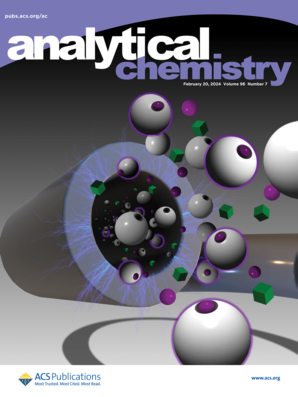精确斯托克斯移位调制在D-π-A化学剂量计中实现三标准次氯酸盐定量阵列
IF 6.7
1区 化学
Q1 CHEMISTRY, ANALYTICAL
引用次数: 0
摘要
合理设计具有明显斯托克斯位移的D-π-A化学剂量计对于增强光传感信号的可视化具有重要意义。本文通过精确调节电子释放强度,合成了3个以2-(3-氰基-4,5,5-三甲基呋喃-2(5H)-乙基)丙二腈(TCF)为吸电子基团的D-π- a荧光化学剂量计。通过降低电子释放能力,识别位点的亲电性提高了1.449 kcal/mol,化学剂量计的Stokes位移提高到201 nm,传感模式从荧光猝灭到比例荧光再到荧光开启。此外,3种D-π- a荧光化学剂量计对ClO -具有较低的检测限(LOD分别为37.0、5.1和1.0 nM)、快速的响应(5 s)和对16种干扰物的选择性等特点。此外,通过便携式三标准定量阵列检测平台进一步验证了化学剂量计的实用性,该平台可定量检测ClO -溶液。所提出的化学剂量计的设计和调制策略可为氧化剂和其他有害化学物质的敏感和可视化识别提供新的途径。本文章由计算机程序翻译,如有差异,请以英文原文为准。

Triple-Standard Hypochlorite Quantitative Array Enabled by Precise Stokes Shift Modulation in D-π-A Chemodosimeters
The rational design of the D-π-A chemodosimeter with a significant Stokes shift is of great importance for enhancing the visualization of optical sensing signals. Here, three D-π-A fluorescent chemodosimeters with 2-(3-cyano-4,5,5-trimethylfuran-2(5H)-ylidene) malononitrile (TCF) as the electron-withdrawing group are synthesized by precisely modulating the electron-releasing strength. By decreasing the ability of electron release, the electrophilicity of the recognition site is increased by 1.449 kcal/mol, the Stokes shift of the chemodosimeter is improved to 201 nm, and the sensing mode changes from fluorescence quenching to ratiometric fluorescence and finally to fluorescence on. Furthermore, the three D-π-A fluorescent chemodosimeters display superior sensing performance toward ClO–, including low limits of detection (LOD, 37.0, 5.1, and 1.0 nM), rapid response (<5 s), and great selectivity in the presence of 16 kinds of interferents. Moreover, the practicality of the chemodosimeters is further validated by a portable triple-standard quantitative array detection platform, which can quantitatively detect ClO– solutions. The proposed design and modulation strategy for chemodosimeters can provide a new pathway for the sensitive and visualized identification of oxidants and other hazardous chemicals.
求助全文
通过发布文献求助,成功后即可免费获取论文全文。
去求助
来源期刊

Analytical Chemistry
化学-分析化学
CiteScore
12.10
自引率
12.20%
发文量
1949
审稿时长
1.4 months
期刊介绍:
Analytical Chemistry, a peer-reviewed research journal, focuses on disseminating new and original knowledge across all branches of analytical chemistry. Fundamental articles may explore general principles of chemical measurement science and need not directly address existing or potential analytical methodology. They can be entirely theoretical or report experimental results. Contributions may cover various phases of analytical operations, including sampling, bioanalysis, electrochemistry, mass spectrometry, microscale and nanoscale systems, environmental analysis, separations, spectroscopy, chemical reactions and selectivity, instrumentation, imaging, surface analysis, and data processing. Papers discussing known analytical methods should present a significant, original application of the method, a notable improvement, or results on an important analyte.
 求助内容:
求助内容: 应助结果提醒方式:
应助结果提醒方式:


